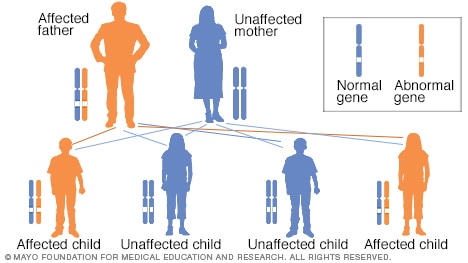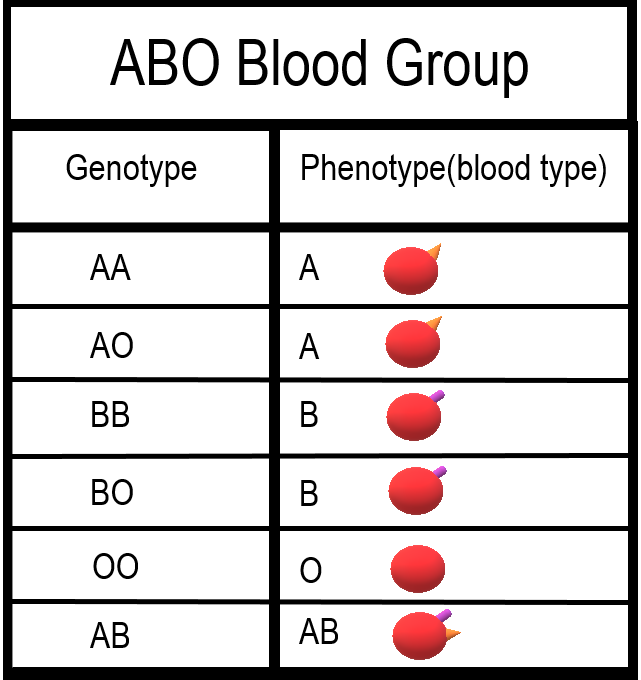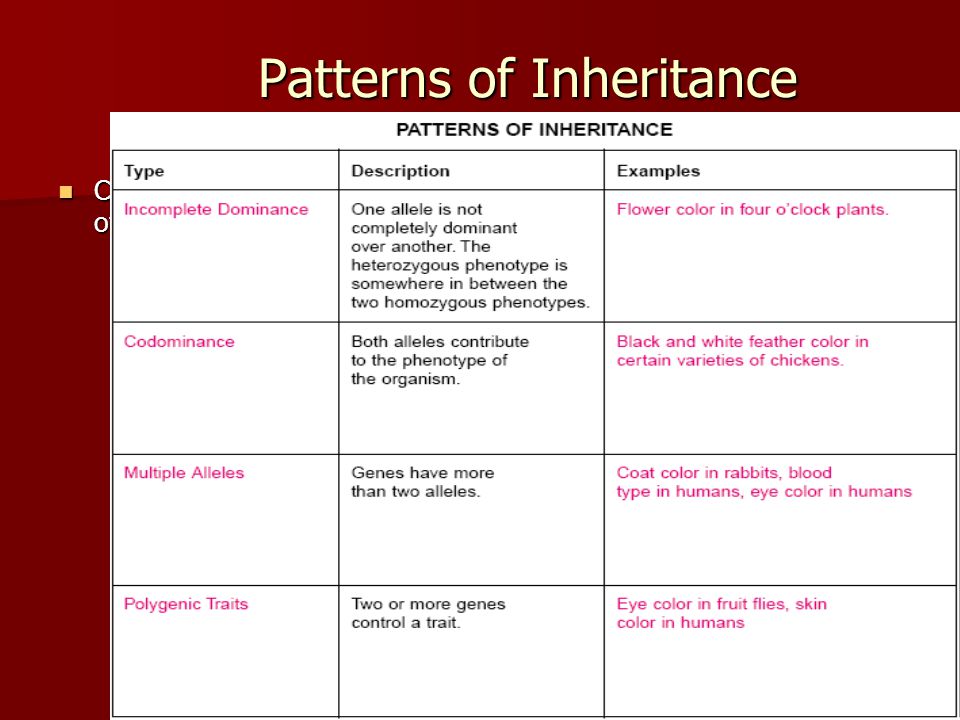Inheritance refers to the transmission of genetic traits from parents to their offspring. In humans, there are three main patterns of inheritance: autosomal dominant, autosomal recessive, and X-linked.
Autosomal dominant inheritance occurs when a person only needs to inherit one copy of a mutated gene from one parent in order to express the associated trait or disorder. This means that if a person has an autosomal dominant disorder, there is a 50% chance that each of their children will also have the disorder. Examples of autosomal dominant disorders include Marfan syndrome, which affects the connective tissue and can lead to heart and skeletal abnormalities, and Huntington's disease, a neurodegenerative disorder that causes problems with movement, cognition, and behavior.
Autosomal recessive inheritance occurs when a person must inherit two copies of a mutated gene, one from each parent, in order to express the associated trait or disorder. This means that a person with an autosomal recessive disorder will not show any symptoms unless they inherit the mutated gene from both parents. If both parents are carriers of the mutated gene (meaning they have one copy of the mutated gene and one normal copy), there is a 25% chance that each of their children will have the disorder. Examples of autosomal recessive disorders include sickle cell anemia, a blood disorder that causes red blood cells to become misshapen and break down easily, and cystic fibrosis, a disorder that affects the respiratory and digestive systems.
X-linked inheritance occurs when a gene is located on the X chromosome, which is one of the two sex chromosomes (the other is the Y chromosome). Since males have only one X chromosome (XY), they are more likely to express traits or disorders that are inherited in an X-linked pattern. This is because they do not have a second X chromosome to compensate for the mutated gene. For females, who have two X chromosomes (XX), the presence of a normal copy of the gene on the second X chromosome can often compensate for the mutated copy. Examples of X-linked disorders include hemophilia, a blood clotting disorder, and Duchenne muscular dystrophy, a progressive muscle disorder that affects mostly males.
In conclusion, the three patterns of inheritance in humans are autosomal dominant, autosomal recessive, and X-linked. These patterns can help to explain how genetic traits and disorders are inherited and can be useful in predicting the likelihood of a person developing a particular disorder or passing it on to their offspring.
Inheritance Patterns

Notice that it does not make any difference whether a person has two I A alleles or one I A and one i allele. Dominant lethal inheritance patterns are much more rare because neither heterozygotes nor homozygotes survive. However, it is quite common for multiple genes to interact to confer a feature. How do I know what type of inheritance I have? But before getting into the details of codominance, let's explain what blood type is. For instance, when he crossed tall and dwarf pure-breeding pea plants, all of the offspring were tall. Sometimes, even if a female inherits the gene change on one of her X chromosomes, she will not show symptoms or her symptoms will be less severe. Independent assortment provides for a great degree of diversity in offspring.
What are the three types of inheritance patterns in humans?

What inheritance pattern is height? This inheritance pattern is shown in the table below, in a form called a Punnett square, named after its creator, the British geneticist Reginald Punnett. The affected child is always female. A daughter can inherit the gene for an X-linked recessive illness when her mother is a carrier or affected, or her father is affected. Scientists have discovered that, unlike eye colour, cognitive function is not influenced by a few genes but by many. Genetics is the study of how heritable traits are transmitted from parents to offspring. People who have two i alleles do not produce either A or B surface antigens: they have type O blood. Their existence is found out only when two heterozygotes marry and the homozygote appears, the ratio 1 normal: 1 affected.
Blood Type Inheritance in Humans

Expression of Blood Types Table 28. But what makes each newborn unique? Applied to pea plants, that means that the alleles associated with the different traits of the plant, such as color, height, or seed type, will sort independently of one another. In the simplest scenario, a single pair of genes will determine a single heritable characteristic. She has a Master's Degree in Cellular and Molecular Physiology from Tufts Medical School and a Master's of Teaching from Simmons College. This allele i produces a nonfunctional enzyme. Carriers for an autosomal recessive disorder may never know their genotype unless they have a child with the disorder.
3 Main Types of Inheritance

The recessive phenotype, which is masked in the second generation, has a 1 in 4, or 25 percent, chance of reappearing in the third generation. Homozygous children lack this transferase enzyme. If the trait is recessive, neither parent is required to have the trait since they can be heterozygous. Inheritance pattern of an autosomal dominant disorder, such as neurofibromatosis, is shown in a Punnett square. The law states that the members of one pair of genes alleles from a parent will sort independently from other pairs of genes during the formation of gametes. Patterns of inheritance in humans include autosomal dominance and recessiveness, X-linked dominance and recessiveness, incomplete dominance, codominance, and lethality.







